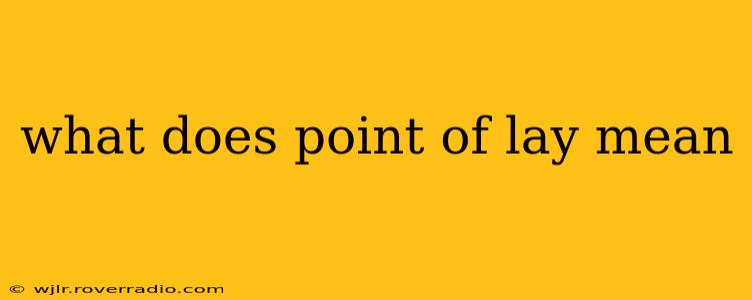"Point of lay" (POL) is a term used in the poultry industry to describe the stage when a hen is about to begin laying eggs or has just started laying eggs. It's a crucial point in a hen's life cycle, marking the transition from a pullet (a young female chicken not yet laying) to a laying hen. Understanding what point of lay means is essential for both commercial poultry farmers and backyard chicken keepers.
What Age Do Chickens Reach Point of Lay?
The age at which a hen reaches point of lay varies depending on the breed. Generally, most commercial layer breeds reach point of lay between 16 and 20 weeks of age. However, some breeds might start laying slightly earlier or later. For example, dual-purpose breeds might reach point of lay a little later than specialized layers. Backyard chicken keepers should consult breed-specific information for a more precise estimate.
What Are the Signs a Hen is Reaching Point of Lay?
Several indicators can signal that a hen is approaching or has reached point of lay:
- Increased Comb and Wattle Size: The comb and wattles (fleshy red parts on a hen's head) will become larger and more vibrant in color.
- Brighter Feathering: The hen's feathers may become brighter and more glossy.
- Squatting Behavior: You might observe the hen squatting more frequently, a posture associated with egg-laying.
- Increased Restlessness: The hen may seem more restless or fidgety than usual.
- Production of Smaller, Softshell Eggs: In some cases, the first few eggs laid might be smaller or have soft shells. This is perfectly normal and should not be a cause for concern.
It's important to remember that these are just indicators, and there is always some variation among hens.
What Happens at Point of Lay?
Reaching point of lay signifies the hen's reproductive system is fully developed and ready to produce eggs. This means her ovaries are mature and capable of releasing yolks, and her oviduct (the tube through which the egg passes) is ready to produce the albumen (egg white), shell membranes, and eggshell.
How Does Point of Lay Affect Egg Production?
A hen's egg production at point of lay is usually not at its peak. It typically takes several weeks for a hen to reach her peak laying rate. Egg size and shell quality will also gradually improve as the hen matures.
How is Point of Lay Important for Commercial Egg Production?
For commercial poultry farms, accurately predicting point of lay is crucial for efficient management. It allows farmers to plan for increased feed requirements, adjust housing density, and prepare for egg collection. This precise timing is essential for maximizing egg production and profitability.
What are the Considerations for Backyard Chicken Keepers?
Backyard chicken keepers should also be aware of point of lay. It helps them anticipate the start of egg production, prepare suitable nesting boxes, and understand their hens' changing nutritional needs.
Why are Pullets Sold at Point of Lay?
Pullets (young hens) are often sold at point of lay or slightly before because this represents a convenient stage for buyers. The buyer can almost immediately start receiving eggs, and the bird has already passed through the most demanding phase of its growth. This is beneficial for both the seller and the buyer, ensuring a smoother transition and minimizing uncertainty.
By understanding the intricacies of point of lay, whether you're a commercial farmer or a backyard chicken enthusiast, you can effectively manage your flock and ensure optimal egg production. Remember to always consult breed-specific information for the most accurate predictions.
